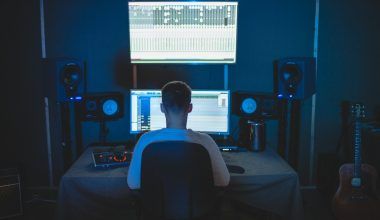If you’ve ever dreamed of creating your own music, you’ve probably come across the terms “DAW” and “MIDI.” These are essential tools in modern music production, and understanding them can unlock a world of creativity. Whether you’re an aspiring producer or just curious about how songs are made, this guide will walk you through the basics of DAWs and MIDI in the simplest way possible.
What is a DAW?
A DAW, or Digital Audio Workstation, is a software application used to record, edit, and produce audio files. Think of it as the heart of your music-making process. With a DAW, you can record live instruments, mix sounds, and create entire songs from scratch—all on your computer. Popular DAWs include Ableton Live, FL Studio, Logic Pro, and Pro Tools.
Why is a DAW so important? It’s because it’s where all the magic happens. Imagine having a virtual studio at your fingertips. You can add effects, layer sounds, and tweak every little detail to make your music sound professional. For beginners, starting with a user-friendly DAW like GarageBand or FL Studio can make the learning process smoother.
Introducing MIDI: The Language of Digital Music
MIDI stands for Musical Instrument Digital Interface. It’s a communication protocol that allows electronic musical instruments, computers, and other devices to talk to each other. Think of it as the digital sheet music for your songs.
Unlike audio recordings, MIDI doesn’t store actual sound. Instead, it stores information about which notes to play, how long to play them, and how hard to hit them. This makes MIDI incredibly versatile. You can easily change the instrument or tempo of a MIDI file without re-recording anything. For instance, a melody you play on a MIDI keyboard can sound like a piano one moment and a saxophone the next.
Why DAWs and MIDI Work Hand-in-Hand
Now that we know what DAWs and MIDI are, let’s explore how they complement each other. A DAW is like the canvas, while MIDI is the paint. Together, they allow you to create detailed musical compositions with precision and flexibility.
Using MIDI in a DAW is straightforward. Most DAWs come with built-in MIDI instruments and sounds. When you connect a MIDI controller, such as a keyboard, you can play and record notes directly into the DAW. Once recorded, you can edit the MIDI data to fix mistakes, change the rhythm, or even swap instruments. This makes MIDI an essential tool for anyone who wants to compose music digitally.
Setting Up Your Home Studio
To get started with DAWs and MIDI, you’ll need a few basic tools:
- A Computer: Most modern computers can handle DAWs, but it’s better to have one with good processing power and RAM.
- A DAW Software: Choose one that fits your style and budget. Many DAWs offer free trials, so you can experiment before committing.
- A MIDI Controller: A keyboard is the most common type of MIDI controller, but there are also pads, guitars, and wind controllers.
- Headphones or Studio Monitors: Good sound is crucial for music production, so invest in quality headphones or speakers.
- An Audio Interface (optional): If you plan to record vocals or live instruments, an audio interface will improve the sound quality.
Getting Started with MIDI in Your DAW
Once you have your setup ready, it’s time to dive in. Open your DAW and connect your MIDI controller. Most DAWs will automatically detect the controller, but if not, check the settings to enable it.
Start by creating a new track and selecting a MIDI instrument. Play a few notes on your controller, and you’ll hear the sound instantly. Record a simple melody and watch as the MIDI notes appear in the DAW’s timeline. This visual representation makes it easy to edit your performance.
Tips for Using MIDI Effectively
- Experiment with Different Instruments: MIDI allows you to switch instruments effortlessly. Try turning a piano melody into a guitar riff or a string section.
- Use Quantization: This feature aligns your MIDI notes to the grid, ensuring perfect timing. It’s great for fixing mistakes.
- Layer Sounds: Combine multiple MIDI instruments to create rich, textured sounds. For example, layer a synth pad with a piano for a fuller effect.
- Add MIDI Effects: Most DAWs include effects like arpeggiators and chord generators to spice up your compositions.
Common Challenges and How to Overcome Them
Like any new skill, learning to use DAWs and MIDI can feel overwhelming at first. Here are some common issues beginners face and how to solve them:
- Latency: This is a delay between playing a note and hearing the sound. Reduce latency by lowering your DAW’s buffer size in the audio settings.
- Complex Interfaces: DAWs can look intimidating. Start with beginner-friendly software and explore tutorials online.
- Limited Creativity: If you feel stuck, experiment with loops, presets, or MIDI packs. They can provide inspiration and save time.
Taking Your Music to the Next Level
Once you’re comfortable with the basics, you can start exploring advanced techniques. For instance, you can use automation to add dynamic changes to your tracks, such as volume swells or panning effects. You can also dive into mixing and mastering to make your music sound polished.
Collaborating with other musicians is another great way to grow. Many DAWs allow you to share projects, making it easy to work on songs together, even if you’re miles apart. And don’t forget to share your work online. Platforms like SoundCloud and YouTube are perfect for showcasing your talent.
Conclusion
Understanding DAWs and MIDI is the first step toward becoming a music producer. These tools might seem technical at first, but with practice, they become second nature. Start small, experiment, and have fun. Remember, every great producer was once a beginner. So, grab your MIDI controller, fire up your DAW, and let your creativity flow. The world is waiting to hear your music!
For further reading, explore these related articles:
- The Amazing Journey of Daft Punk: Music Legends Who Changed the World
- AMA 2022 Winners: The Big Night in Music
For additional resources on music marketing and distribution, visit DMT Records Pvt. Ltd..






